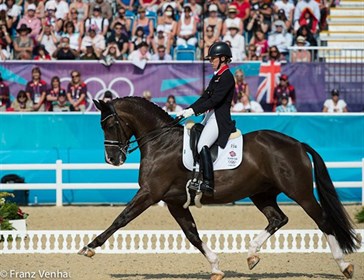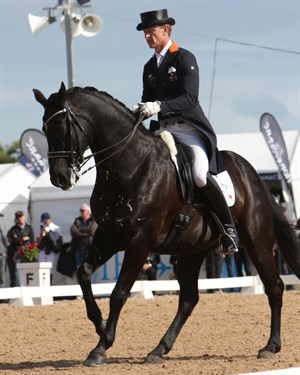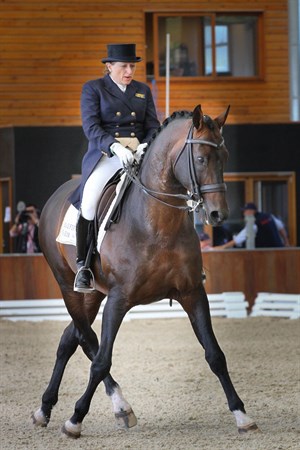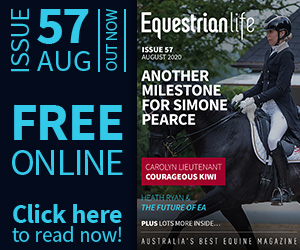
This article first appeared in a previous issue of Equestrian Life magazine. To see what's in our latest, free digital issue, click here.
Harmony between horse and rider creates unity in movement.
© Franz Venhaus
No, this isn’t about singing with your horse. Being in tune not only refers to melody, of course, it also means concord or agreement, harmony. It is part of the art of horsemanship.
BY DR KERRY MACK
IT IS INTERESTING that the right (non-dominant) hemisphere of our brains that is involved in musicality and other artistic endeavours is also involved with the process of being in tune, or empathic. As horse riders and trainers, we all enjoy our relationship with the horse, we value the idea of harmony. Over the past few decades much has been written about herd behaviour in horses. This has been the basis for thinking about the horse/human relationship as if the human is a part of the herd. The human should be the leader of the herd when we think about the relationship in this way. Of course, we wouldn’t want a horse to be the leader as that would likely be unsafe.
I have become interested in another way of thinking about the horse/human relationship, which is informed by attachment theory. We know that all mammals depend on an attachment to their (milk-producing) mother for survival. This is the first, and therefore archetypal, relationship. I have written about this before (you can find the article in the EQ Life Archives online). I want to expand on this idea, based on what we know about attachment from the very detailed studies that have been done. In this model, the rider/trainer is more like a parent. I am sure that you can see the difference, subtle though it is, between us being the leader of the herd and being like a parent. The rider tries to foster a relationship of trust with the horse. The rider wants the horse to experience the rider as if they were bigger, stronger, wiser and kind. We use this idea with our foals to get them to learn that we are bigger and stronger in those first few days when we are for a short time stronger than the foal. We want to be wiser in so far as we want to use our judgment a bit like a foal will use his mother’s judgment. We want him to see that if we think something is safe he can treat it as safe as well. Of course, young horses do better with confident experienced riders.
Brett Parbery and DP Weltmieser.
© Roger Fitzhardinge
We know from studies in attachment that when attachment is secure, the child uses the parent as a safe base to explore the world and a safe haven to return to when stress, unfamiliarity or uncertainty trigger the need for comfort. Wouldn’t it be nice if your horse showed those qualities in its relationship with you? We can examine some of the qualities of attachment relationships that work well. You will see that although these qualities each have specific definitions there is overlap of the qualities.
Secure attachment can result when partners in a relationship are attuned to each other. Attunement is a quality of relationships where one or both members of the partnership are in tune or paying attention to the emotional and bodily states of the other. We all hear of the horse whisperers, those talented people who are so attuned to the signals of the horse that they notice very subtle signs of the horse’s mental state. They can respond to these signs and get horses to cooperate with signals that most of us can’t see. They can hear the whispers of the horse and whisper back, in contrast to those of us who only notice the horse shout, and shout back. Horses whisper to us with their bodies, including with their ears, which point to where their attention is and can also show us their feelings. We all know to beware of the horse with his ears pinned back, the horse shouting his aggression. Horses whisper to us with their mouths, chewing to indicate relaxation and submission. We can feel this whisper through the reins as well if we have relaxed fingers and a stable, soft contact.
Kerry Mack and Mayfield Pzazz working in harmony.
© Michelle Terlato Photography
Horses whisper to us with their hearts. We can feel the beating heart of a stressed horse in our legs, see the sweat on their necks, and hear their breath as they snort in tension or blow rhythmically when relaxed. They whisper with their necks, a low, soft neck showing relaxation or a high head held on a rigid neck expressing tension. The tension in their muscles and their tails all can tell us about what is happening if we are attuned to it. They can whisper to us with their whole bodies moving into us.
We can be attuned to our horse on the ground. I think that most groundwork is to increase attunement between horse and handler. We can notice them move into our space just as they start to crowd us, and respond to them with a gesture that pushes them away. We are asserting our primacy rather than waiting until they shout their intention to be the boss by stepping on us. We can move them around with small signals from our hands, our bodies, a flag or other aid. We can be attuned to our horses when we are riders. When we are handlers and when we are riders we train horses to respond to small signals using techniques informed by learning theory. We release the pressure of the aid when the horse responds. When we are attuned we notice the small responses and remove pressure accordingly.
If we can tune in to these subtle communications from our horses we can respond more sensitively. As we respond more sensitively to the horse, the horse will respond more sensitively to us. When we become attuned to the horse, he will become more attuned to us. He slows a little, we correct it with a small aid backed up by a stronger aid and he starts to go forward off the lighter aid. We lean back and sit down a little before we use the rein to slow him down. Before long he becomes attuned to the subtle aid and balances in preparation for the down transition before we ask with the rein. Each partner in the relationship becomes sensitive to small cues from the other.
The good rider feels when the horse first signals that he is nervous about a strange object. The rider takes action to encourage the horse by bending him away from the feared object, pushing him sideways, getting his head low in the posture of relaxation etc. The good rider doesn't wait for the horse to spin around and run away. The good (attuned) rider feels the tension in the horse’s body as he begins to not want to go forward into the contact. The rider may be able to keep his horse’s feet moving by using two legs to kick him forwards, or one leg pushing the quarters out, bending the horse in a small circle. The rider doesn't wait until the horse refuses to go into the contact, perhaps rearing up. The rider attuned to the horse will often notice a potential problem early enough to avoid a fight.
When we are attuned we respond to the whispers of the horse contingently. The parent/rider should respond to the child/horse based on what they are signalling that they are experiencing. The rider can take the legs off when the horse travels actively forwards, and when the horse slows down, the rider reacts with the leg. There is no need to keep kicking if he is already going.
Reciprocity is another quality of attuned interactions. The response of one individual to the action of the other is a relationship of mutual dependence or action of influence. The horse goes to stop of his own choosing, and the rider kicks him forward. Not that the rider keeps kicking with his legs even though the horse is going forward. The rider is thinking that he is preventing the horse from stopping, but he is more likely teaching the horse to become habituated to the leg, that is, to ignore the leg. The rider’s action is not in response to the horse’s action, but only in response to the rider’s thoughts. The rider kicks and the horse’s reciprocal action is to go forward. The rider’s leg comes off, contingently and reciprocally.
You can see that the idea of the rider/handler being attuned to the horse, providing a safe haven, acting in a way that the horse experiences as secure attachment to the rider, is another model or way of thinking about the relationship with the horse. This is compatible with learning theory and with what we know about horses as a herd animal. It is an idea that promotes empathy and harmony. This model equates the role of the trainer to the role of a parent; someone who helps organise the world around the “minor” (child/horse), someone who helps the horse develop and who helps the horse learn about the world. Using this model, it is important that the parent/trainer is consistent and fair. They should be experienced by the horse as bigger, stronger, wiser and kind, but should not be frightening. Maybe more of that another time.
Have fun.
READ THE LATEST NEWS ARTICLES HERE
https://www.equestrianlife.com.au/articles/In-harmony-with-your-horse_



